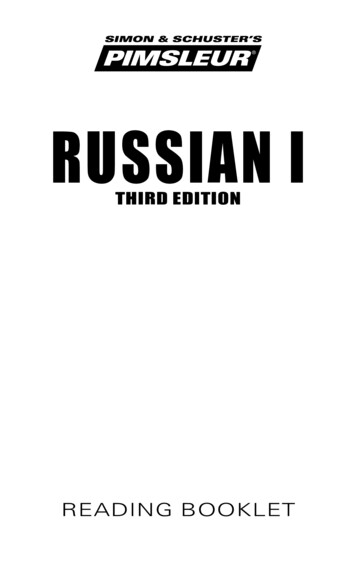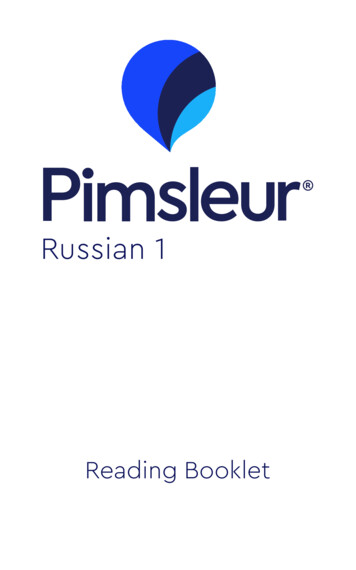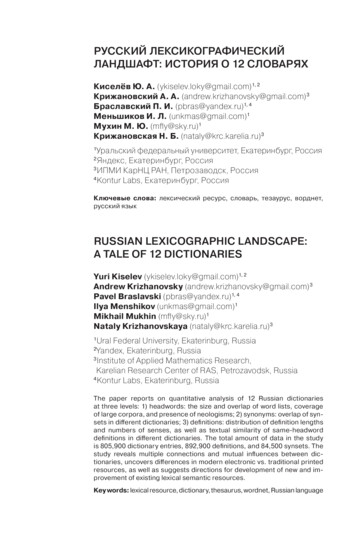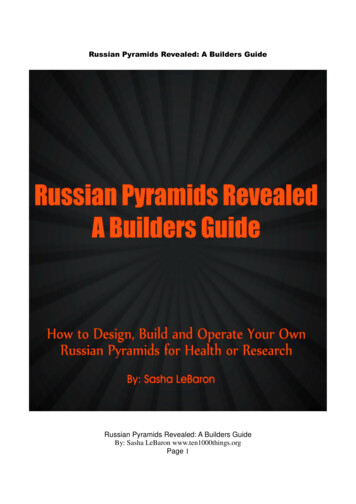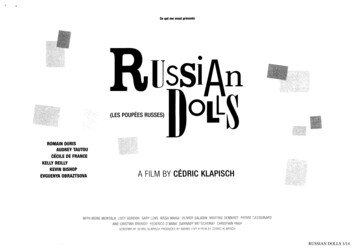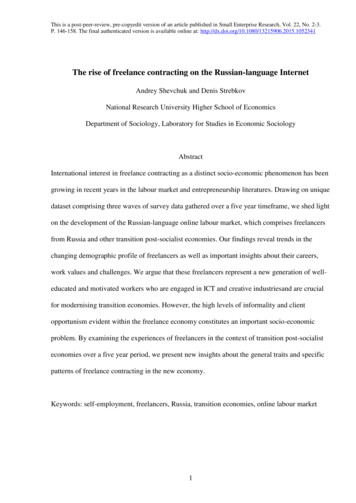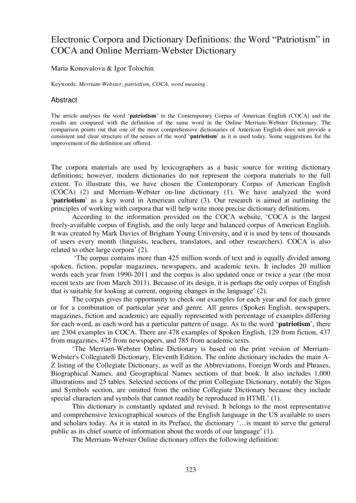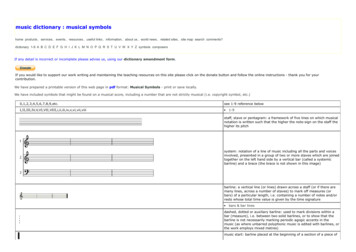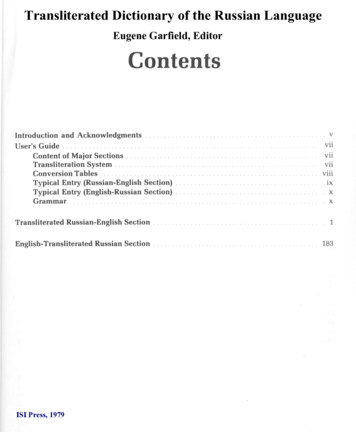
Transcription
Transliterated Dictionary of the Russian LanguageEugene Garfield, EditorISI Press, 1979
Transliterated Dictionary of the Russian LanguageClick below to go to each section, or scroll down to read entire introductionTransliteration SystemConversion TablesTypical Entry (Russian-English Section)Typical Entry (English-Russian Section)User’s GuideContent of Major SectionsThis dictionaryconsists of two major sections. The Russian-to-Englishsection lists nearlywords that have been transliteratedfrom the Cyrillic to the Roman alphabet.These words are listed accordingto the order of the Roman alphabet.In additionto thetransliteratedform, brief definitionsand designationsof parts of speech are providedforeach Russian word. In the English-to-Russiansection, English words are listed in Romanalphabeticorder with each word followed by its transliteratedRussian equivalentand a partof speech designationfor the Russian word.The English-Russiansection of this dictionaryis unusual in many respects. It was compiledby re-sortingthe Russian-Englishsection. Since the Akhmanova-Wilsondictionaryincludesthe most frequentlyused Russian words, one might conclude that the re-sorted version wouldinclude all of the most commonlyused English words. This is not the case. A number of themost familiarEnglishwords did not appearin the Akhmanova-WilsontranslationsofRussian words. The result is that the omitted words do not appear as entries in the EnglishRussian section.The English-Russiansection does, however, illustratethe richness of the Russian languagein providingmany subtle shades of meanings.This is shown by the array of Russian termsrequired to translatesome of the English words that were used by Akhmanova-Wilson.Forexample,five differentRussianwords are providedas translationsfor the English word“departure.”Also, in English a “deviation”may be a departurefrom the norm. In Russianthe term closest to this is “otklonenie.”However,severalother Russianwords conveydifferent shades of meanings:“deviatsiya”means “deviation,”as in a compass; while “uklon”means “deviationor deflection,”in a political sense.17,000 RussianTransliterationSystemConversiontables in this guide and at the endleavesallow the user to convertCyrillicletters into their Roman equivalentsand vice versa. The words containedin this dictionarywere transliteratedby the staff of the Institutefor ScientificInformationfollowingthesystem of the British StandardsInstitute(BSI). This system was used because it seemed tocombine the best features of two other leading systems, the Library of Congressand Boardof GeographicNames. The British StandardsInstitute system’s lack of ambiguityand absenceof ligatures make it a useful system for personneluntrainedin linguistics.In addition,it is asystem that has been used by several English-languagepublishersof Russian materialsandby many agencies of the United States government,such as the National Science Foundationand the Departmentof Agriculture.Since the Library of Congress system agrees with the BSIsystem in all but a few instances,it is a simple matter to convert one system to the other.There may be, however, some effect on the ordering of words when one system or the otheris used.vii
.User’s GuideVI11There are few transliterationsystems that can be applied in practical situationsexactly asconceived.In this dictionaryit was necessaryto modify the BSI system slightly by ignoringthe diacriticalmarks over the Cyrillic E and w . Thus, the Cyrillic ii is transliteratedas a Romane, and VI is transliteratedas a Roman i. All other transliterationsare in strict conformityto theBSI system. (Individualsinterestedin learningmore about transliterationsystems will finda wealth of useful informationin H. H. Wellisch:The Conversionof Scripts, John Wiley &Sons, 1978.)Conversion TablesThe following tablesshow the charactersof the Cyrillicalphabetand their Romanequivalents as used in this dictionary.The Cyrillic-to-Romantable is arranged’ in order of theCyrillic alphabet. The Roman-to-Cyrillictable is arranged in the order of the Roman alphabet.Since the Cyrillic alphabetcontainsmore letters than the Roman, combinationsof RomanC yrillicAWVBrA fkhtschshshchp/AWVYA 6zh#YuYaC yrillicZ
User’s Guideixletters and two special symbolsare used to representthose Cyrillic letters for which thereare no correspondingcharactersin the Roman alphabet.The latter includethe so-called“soft” (b) and “hard” (%) signs, also known as the “silent letters,” for which the single prime(I) and double prime (11)symbols are used.The reader should note carefullythat unambiguous,one-to-onereversibilityof Romancharactersto their Cyrillic equivalentsis difficult. This is because some Roman letters, suchas “h,” ,,j,,) ,,q,” “w,” and “x,” representsounds that are hard to reproducein an unambiguousway with Cyrillic letters. The Russiansapproximatethese sounds as CWX(g)(dzh)(kV )V(1(kS 1Thus, the name Hilbert is cited as Gilbert, Woodwardas Voodvard.While this precludescomplete letter-for-letterreversibility,the method typicallyused by the Russiansto transliterate English words serves the needs of the Russianreader, just as the system used totransliteratethe Russian words in this dictionaryserves the needs of the English-speakingreader.Typical Entry (RussianlEnglishSection)The following is a typical entry in the transliteratedappear for the Russian word AJlbMAHAX:.Russian-to-Englishsectionas it wouldEnglishdefinition The boldfaceentry is the transliteratedRussianword. The abbreviationnext to eachtransliteratedword indicatesthe part of speech in accordancewith the .n. collect.n. t.n. m.n. m. 81 ioninterjectionintroductorywordcollectivenounnoun femininenoun masculinenoun;couldbe eithermasculineor femininen. n.n. pl.num.P*part.pred.prep*v. impf.v. impf.v. pf.& pfnoun neuternoun nverb in the imperfectiveaspectverb; can be either perfective or imperfectiveverb in the perfectiveaspect
User’s GuideXFollowingthe part of speech is a simple (usually one-word)English definition.Occasionally, secondarydefinitionsor shades of meaningsare provided.Definitionstaken from theAkhmanova-Wilsondictionarythat were archaic or orientedto British usage have beenmodified to conform as much as possible to modern Americanusage. Informationrelated toetymology,idiomaticuse, and syntacticor semanticrequirementsis omitted.Some additionalconventionsfollowed in this dictionaryare as follows:-thehard and soft signs are ignored in the alphabetizationof transliteratedRussian wordsin which they appear, as is the accent mark over the e.-thereflexiveending sya appearsin parenthesisfollowingcertainverbs. When thisoccurs, it indicatesthat the English definitionis the same for the verb stem when it iscombinedwith the sya ending as it is for the stem alone.-pronouns,days of the week, months, and most proper adjectivesare not capitalizedinRussian.Geographicdesignationsare capitalizedwhen they apply to formal politicalinstitutionsor units.-a few Russianwords have English definitionsthat would seem to require additionalclarification.In such instances,a modifyingword has been added, parenthetically.Example:kumys (n.m.)koumiss (a type of beverage)Typical Entry (bgfkh-RussianAll conventionsscribed previously.Section)followedin the English-to-transliterated-RussianThe followingis a typical entry in this )GrammarEach entry containsonly a single form of the transliteratedRussian word rather than theusual range of grammaticaland lexical variationsfound in most traditionaldictionaries.Inview of this, the followinggeneral discussionof Russian grammar may be helpful to the userwho wishes to go beyond the primary purpose of the dictionary.Grammaticalcategories in Russian consist of the following features: voice, person, number,gender, case, mood, tense, and some others. By combiningthese featuresinto a bundle,aparticularpart of speech is formed. Thus, noun endings combinedwith the stem form thecategoriesof case, number,gender, and animateness.Verbs are formed by combiningthecategoriesof tense, person, number,voice, and mood. Adjectivesare characterizedby case,number,and gender. Parts of speech such as those mentionedabove are called inflected.Ifno grammaticalcategoriesare added to the stem of the lexical meaning,as is the case withthe adverbs, prepositions,conjunctions,and particles,these words are called uninflected.Inmost specific terms, inflected words are subdividedinto those which are subject to declension(nominalinflection)and those which are subject to conjugation(verbal inflection).
User’s GuidexiThe inflected forms are representedonly by a specific form from the set of related inflectedforms, Thus, the nouns are representedby the nominativecase, gender, singular number;verbs by their infinitive form; adjectives by singular number, nominative case, and masculinegender. Pronouns,due to their small numberand high frequency,are enteredin all theirforms. Therefore,the pronounya (I), is includedas well as the declinedforms menya, mne,mnoi. So are the other pronouns.The dictionaryentries as defined above are referred to ascanonicalforms.Canonicalforms are the basis for the lookup. The user should match the word from thetext, say, podpiskami,letter by letter from left to right until either the whole word or part ofit is matched against the dictionaryentry. If there are two matchingforms of varying length,the longer form should be chosen. The remainingportion of the word should not consist ofmore than three letters(or four, in the case of the ending-yami which indicatestheinstrumentalplural for palatalizednoun stems). In our case, we will find two entries: podpis’and podpiska. We choose podpiskabecause it is the longest match, leaving the portion -mi.Combiningthe entry with the stem -mi we get podpiskami,where the ending -ami showsinstrumentalplural for nonpalatalizednouns.Back to Contents Page
This dictionary consists of two major sections. The Russian-to-English section lists nearly 17,000 Russian words that have been transliterated from the Cyrillic to Roman alphabet. These words are listed according to the order of the Roman alphabet. In addition to theFile Size: 2MBPage Count: 8
